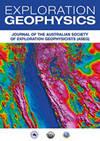利用无屏蔽GPR系统采集的CMP数据分析地下速度:来自试验性NAPL污染试验场的结果
IF 0.8
4区 地球科学
Q4 GEOCHEMISTRY & GEOPHYSICS
引用次数: 0
摘要
准确的数据成像和深度转换以及量化土壤含水量的分布都需要足够的速度知识。如果没有沿剖面的介电常数和/或孔隙度测井形式的补充钻孔信息,目前就不可能可靠地估计被探测地下区域中的高频电磁速度分布。在这里,我们提出了一种新的方法,用于根据探地雷达(GPR)反射数据计算精确的地下速度结构,该方法不需要钻孔或测井数据。本研究调查了pulse_EKKO PRO探地雷达系统预测垂直剖面的能力,用于中国杭州一个分层和污染的地球物理试验场的可能速度估计。在使用GPR软件进行分析之前,所有数据都被采集并保存在GPR系统的各种文件(项目)中,以使用公共中点(CMP)道集获得近似速度建模。使用速度谱分析,可以从每个CMP道集导出层间速度的垂直剖面。本研究的结果表明,所提出的方法是有效和可持续的。此外,由于该方法在野外工作和计算复杂性方面的有效性,它可以很容易地扩展到三维探地雷达速度勘探,与使用探地雷达估计速度的基于标准偏移量的技术相比,它的重要性增加了。本文章由计算机程序翻译,如有差异,请以英文原文为准。
Analysis of subsurface velocity using CMP gathers picked up by unshielded GPR system: results from an experimental NAPL contaminated test site
Adequate knowledge of velocity is required for accurate data imaging and depth conversion, as well as for quantifying the distribution of soil water content. Without complementary borehole information in the form of dielectric permittivity and/or porosity logs along the profile, it is currently impossible to reliably estimate the high-frequency electromagnetic velocity distribution in the probed subsurface region. Here, we present a new method for calculating the precise subsurface velocity structure from ground penetrating radar (GPR) reflection data that does not require boreholes or log data. This study investigates the ability of the pulse_EKKO PRO GPR system to predict a vertical profile for the possible velocity estimation of a layered and contaminated geophysical test site in Hangzhou, China. All data were acquired and saved on the GPR system in various files (projects) before analysis using GPR software to obtain approximated velocity modelling using common midpoint (CMP) gathers. Using the velocity spectrum analysis, a vertical profile of the interval velocities can be derived from each CMP gather. The findings of this study indicate that the proposed method is effective and sustainable. Furthermore, owing to the efficacy of the method in terms of field effort and computational complexity, it can easily be expanded to 3D GPR velocity exploration, increasing its importance in comparison to standard offset-based techniques for estimating velocity using GPR.
求助全文
通过发布文献求助,成功后即可免费获取论文全文。
去求助
来源期刊

Exploration Geophysics
地学-地球化学与地球物理
CiteScore
2.30
自引率
0.00%
发文量
33
审稿时长
>12 weeks
期刊介绍:
Exploration Geophysics is published on behalf of the Australian Society of Exploration Geophysicists (ASEG), Society of Exploration Geophysics of Japan (SEGJ), and Korean Society of Earth and Exploration Geophysicists (KSEG).
The journal presents significant case histories, advances in data interpretation, and theoretical developments resulting from original research in exploration and applied geophysics. Papers that may have implications for field practice in Australia, even if they report work from other continents, will be welcome. ´Exploration and applied geophysics´ will be interpreted broadly by the editors, so that geotechnical and environmental studies are by no means precluded.
Papers are expected to be of a high standard. Exploration Geophysics uses an international pool of reviewers drawn from industry and academic authorities as selected by the editorial panel.
The journal provides a common meeting ground for geophysicists active in either field studies or basic research.
 求助内容:
求助内容: 应助结果提醒方式:
应助结果提醒方式:


